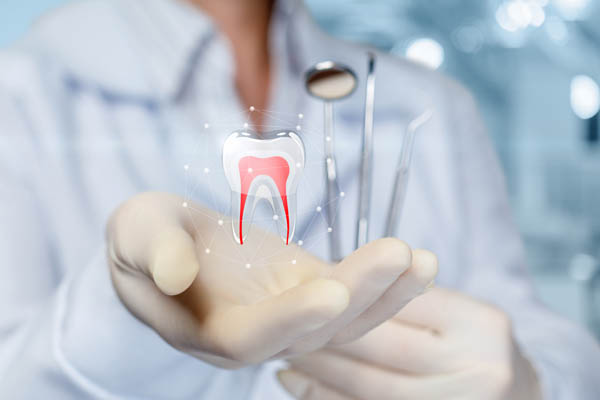A Root Canal Can Save Your Injured Tooth

When a tooth needs a root canal, it is usually because of either a deep cavity, a break, a crack, or a chip that has gone through the hard protective enamel of the tooth. Under the enamel is a softer tissue called dentin and then under the dentin in the center of the tooth is the pulp. This pulp in the center of the tooth contains blood vessels and nerves that bring life to the tooth. When the tooth enamel is broken or worn away, exposing the soft dentin allows bacteria to get into the tooth pulp.
Once there is a way for bacteria to get into the pulp of the tooth, there is no way to stop it. The dentist is not able to create a seal that is effective enough to replace the tooth enamel. This means that while the tooth infection can be treated with antibiotics, that infection would keep coming back unendingly, and there was a time when this meant the tooth had to be removed to save a patient's health.
Why a root canal can save a tooth
The one and the only way to save a tooth that has an opening of some sort running through its enamel is to first have the infected pulp inside the tooth removed. Then, the remaining space known as the pulp chamber, is sealed up with a material that will keep bacteria from traveling inside the tooth and into gums, jaw, and bloodstream.
This process has become very common, and while it was once regarded as unpleasant, thanks to modern anesthetics, patients are feeling no pain during, this allows the dentist to work more freely and efficiently at cleaning out and sealing this tooth so that patients can keep the tooth and underlying root in their jaw.
In addition to better anesthetics, a dentist also has motor handpieces that are far more accurate than cleaning by hand. The procedure is much faster and more effective now. There are also ultrasonic instruments that assist with canal irrigation and cleaning and also nickel-titanium files that are better for removing the pulp and all infections.
Other technological improvements are surgical microscopes to ensure the infection has been completely eradicated and digital X-rays that allow the dentist to see the tooth roots with amazing accuracy. It is also good to know that digital X-rays produce less radiation, and there is no delay in their development time, and this is one more reason the procedure moves quickly.
Crowning the tooth
Once a tooth has been root canaled, your general dentistry office will want to have a crown made up and then install it. A crown is a covering that is designed to fit over the top of the tooth and is sealed to it. While crowns used to be made of a variety of visible materials, including gold and silver, they are now usually made with a composite material that matches the appearance of the patient's natural teeth. To place the crown, the underlying tooth is trimmed down slightly to ensure the crown does not impact the patient's natural bite pattern.
There are many benefits to getting a crown. It will add structural integrity to the tooth so that it lasts much longer, usually decades. The crown will also look beautiful in the mouth and deflect food from sitting on the tooth. Aside from the pulp being gone, patients will have a fully restored tooth, and they will be able to chew their food with it, which will make dining much more pleasurable.
Determining the best action for an infected tooth
It can be difficult for patients to decide if they want to try to save a tooth or have it removed. That is why individuals that have a known cavity or tooth pain should seek dental care as quickly as possible. Dentists have the ability to understand what is happening inside the tooth and help people understand their options. While dentists typically always want to keep a tooth in the mouth, they can work with patients to understand their concerns and design an appropriate treatment plan. Root canals are one of the final steps that a dentist can make to help eliminate the pain caused by an infected tooth, and to help save the tooth before it requires removal. This allows dentists to maintain the form, function, and appearance of the tooth without having to remove the tooth and replace it with a bridge or dental implant.
Request an appointment here: https://www.southerncalsmiles.com or call Southern Cal Smiles: Susan Fredericks, D.D.S, M.P.H. at (818) 657-8055 for an appointment in our Woodland Hills office.
Check out what others are saying about our dental services on Yelp: Root Canal Treatment in Woodland Hills, CA.
Related Posts
Curious about the root canal process? This review discusses the specifics of what you can expect when visiting a dentist for root canal treatment. Read on to learn more about this type of restorative treatment.Every dentist has their own process for root canal treatment, but there is a general process that most follow with patients.…
You might need an emergency dentist if you are dealing with an unexpected dental issue or injury that requires immediate treatment like a knocked-out tooth, unbearable toothache, or infected tooth. Waiting a couple of weeks for a dental appointment does not cut it in these situations.An emergency dentist can help you navigate around unforeseen dental…
If you have a toothache causing terrible pain, you may need to visit the emergency dentist. Minor toothaches can be adequately controlled with home treatments and over-the-counter toothache solutions, so you may not need to see an emergency dentist.When dealing with a toothache, the underlying reason and symptoms indicate whether emergency dental treatment is necessary.…
Fixing a broken tooth right away is important. This dental damage may seem like nothing more than a cosmetic problem, but it can lead to terrible consequences. Seeing a dentist sooner rather than later can provide immediate relief. If you want to find out the treatments for a broken tooth and its complications, here are…


